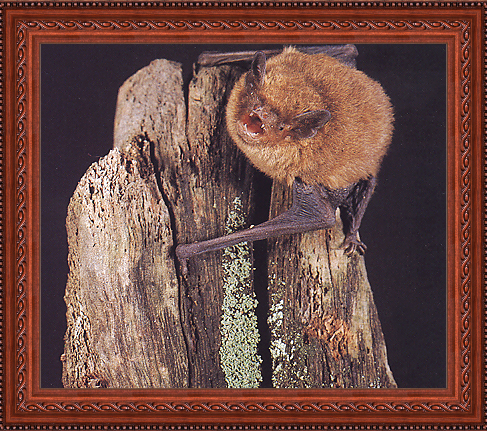

Pipistrellus pipistrellus
Common Pipistrelle Bat
The pipistrelle has tiny, very sharp teeth. These are ideally suited to chewing the soft body parts of the small insects, such as caddisflies which form the bulk of it's diet. Its flight is fast and rather jerky and it often flies low over the ground as it searches for flying insects. Like all bats pipistrelles are creatures of habit and tend to follow the same routes every night. On summer nights pipisrelles are often seen flying at the height of only 8 inches to 6·5 feet over water, picking up adult caddisflies and other insects as they take flight after emerging from their nymphal or pupal stages. Pipistrelles feed several times during the course of the night resting between each to allow some digesting to take place. Their feeding can take them a few miles fron their roosting site therefore they roost in trees during digestion and only return to the main roost just before dawn.General Biology:
Mating occurs in autumn but fertilisation is not immediate. The female store the sperm in her uterus during hibernation, and fertilisation takes place in April or May. The length of gestation depends on weather and as a result births may occur as early as the second week in June but mostly they occur in the last week of June. Each female gives birth to a singl offspring which is immediately suckled. The young bat start to fly at only three weeks old.Little is known about where pipistrelle bats hibernate as they are difficult to find in winter. It is thought that both males and females hibernate together. Pipistrelles like to hibernate at a temperature of 2°C ( 36°F ). They hibernate from late Novenber until late MarchSize: Forearm 28-35 mm ( 1 - 1.5 inches ) Head and Body 40 mm ( 1.5 inches ) Weight is 5 - 7 grams ( 1/5 oz )
Colour: Brown, pale buff, red, chocolate, sometimes blackish, paler below can be greyish
Breeding Season: Autumn through Winter
Gestation Period: 45 - 70 days
Number of Young: One baby is born usually in the last week of June. They grow quickly and begin to fly at three weeks old
Food: Caddisflies and small moths
Predators: Hawks owls and men
Distribution: Widespread throughout the British Isles.